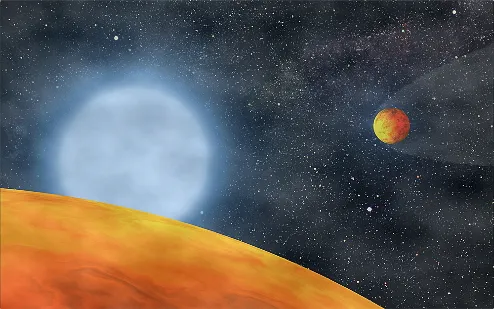
The two planets are believed to have been burned up by their parent star – and survived
Illustration: S Charpinet
In another startling discovery by the Kepler mission, scientists have identified two very small exoplanets in orbit around a dying, post-red giant star, KIC 05807616.
The new exoplanets, KOI 55.01 and 55.02, may be among the smallest yet detected, at 76 and 87 per cent the size of Earth. They orbit their parent star very closely and are tidally locked to it; that is, one side of each planet always faces the star, just as one side of the Moon always faces Earth.
Because of their proximity to their star, it is believed the two planets must be the rocky remnants of two much larger gas giant planets that were engulfed by the star in its red giant phase. This would have stripped off the liquid and gaseous layers, leaving the core to re-emerge once the red giant began to diminish and take on the 'subdwarf B' characteristics we see today.
The discovery has implications for our understanding of how star systems work – it was once assumed that an expanding red giant star would destroy any planets in orbit around it, but this now appears not to be the case. Conversely, it also raises questions about how the presence of an orbiting planet may affect a star's life cycle.
The team who spotted the planets, led byStéphane Charpinet of the Institut de Recherche en Astrophysique et Planétologie in Toulouse, France, were not actually looking for exoplanets at all. Rather, they were studying the brightness variations of pulsating stars to see what they could deduce about the stars' internal composition, when the Kepler data they were using revealed the presence of the two planets.
Steve Kawaler, Iowa State University professor of physics and astronomy, and leader of the Kepler Asteroseismic Investigation who helped the research team study the Kepler data, said:"This is a snapshot of what our Solar System might look like afterseveral billion more years of evolution.This can help us learn about the future of planetary systems and of our own Sun."
As temperatures on the 'day' side of the planets can reach up to 9,000°C, neither is thought likely to support life.
